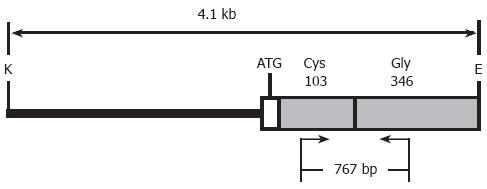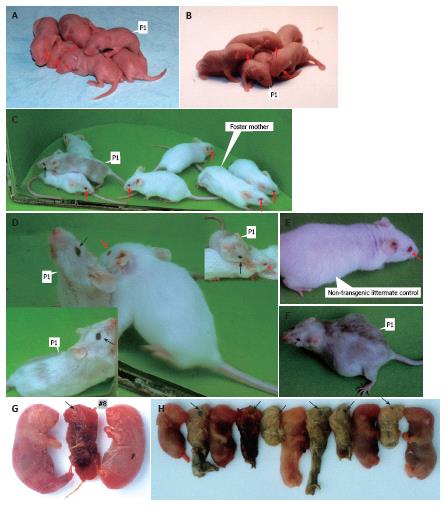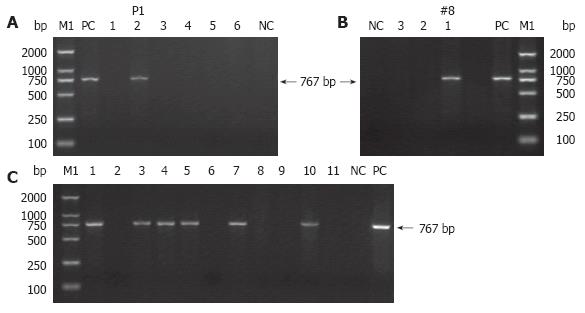Copyright
©2007 Baishideng Publishing Group Co.
World J Gastroenterol. Jan 14, 2007; 13(2): 244-249
Published online Jan 14, 2007. doi: 10.3748/wjg.v13.i2.244
Published online Jan 14, 2007. doi: 10.3748/wjg.v13.i2.244
Figure 1 The structure of tyrosinase minigene construct TyBS used for microinjection.
The construct contains a 2.25-kb tyrosinase promoter, i.e., 5’ non-coding flanking sequence of mouse tyrosinase, as a single thick line plus 65 bp of tyrosinase exon I (to the Xho I site) and 1.785-kb Xho I-EcoR I fragment (shaded) (derived from Tyrs-J) containing tyrosinase cDNA and 3’ non-coding flanking sequence. TyBS encodes cysteine at amino acid 103 and glycine at amino acid 346. The 4.1-kb injected fragment was obtained by pTyBS digestion with Kpn I and EcoR I. The restriction sites are: E, EcoR I; K, Kpn I. The primers specific for TyBS used in PCR reaction (small arrows) and the expected size of PCR products are indicated.
Figure 2 Eye and coat colors of tyrosinase minigene transgenic Kunming albino mice.
One foster mother gave birth to six F0 pups (A-F); among the littermates, only one mouse (referred to as P1) had the pigmented eyes at birth. On July 15, another foster mother produced three F0 pups (G); of three siblings, only one mouse (referred to as #8) indicated the pigmented eyes at birth. P1 (♀) was crossed with normal Kunming albino mouse to give birth to 11 F1 offspring (H). All of the common albino strains of laboratory mice, such as FVB/N, BALB/c, and Kunming mouse (in China), have pink eyes and albino skin. (A and B) The 2-d-old littermates. At birth, one pigmented mouse (P1) with dark eyes could be easily and immediately identified as a transgenic mouse by simple visual inspection. (C) The 4-wk-old littermates and Kunming albino foster mother. Founder P1 exhibited black eyes and light grey fur when compared to the non-transgenic littermate controls and Kunming albino foster mother with pink eyes and albino skin. No differences in phenotypes between transgenic mouse and the controls and foster mother except for melanization in eyes and hairs. Actually, the Kunming albino mouse was also used as a recipient strain for TyBS transgene in this project. (D) Eye color of the 4-wk-old P1 mouse compared with one of the non-transgenic littermates. One of the non-transgenic littermates (right of the middle map) had pink eyes, while at this age the heterozygote P1 (left of the middle map, upper and lower) had nearly black eyes. (E and F) The 8-wk-old non-transgenic littermate control and the adult P1 mouse (8-wk old), respectively. The non-transgenic littermate control (E, left) had pink eyes and albino coat, while at this age the heterozygote P1 mouse (F, right) had nearly black eyes and dark grey coat. Over time, the coat of P1 mouse became more heavily pigmented, while the eye and fur phenotypes of non-transgenic littermate control remained pink and albino throughout the life, respectively. (G) Eye color of the 1.5-d old #8 compared with its littermates. At birth, #8 with dark eyes could be easily and immediately identified as transgenic mice by simple visual inspection. Unfortunately, #8 as well as non-transgenic littermates without dark eyes were killed by foster mother 1.5 d after birth. (H) Eye color of F1 offspring (11) developed from mating of P1 and normal Kunming albino mouse. Founder P1 (♀) was back-crossed to normal Kunming albino mouse to produce eleven F1 generation. Unluckily, all of F1 offspring (11), born on September 8, died immediately at birth. P1 also deceased one month after delivery as it did not recover from giving birth to pubs. Of the 11 animals that developed from the mating aforementioned, six mice exhibited pigmented eyes. → and → indicate the pigmented eyes and non-pigmented eyes (pink), respectively.
Figure 3 PCR detection of TyBS gene from genomic DNA of the potential transgenic founders (A and B) and subsequent generation(s) (C).
Lane M1: DL 2000 DNA Marker (TaKaRa); lane PC: positive control (TyBS as template); lane NC: negative control using genomic DNA from normal Kunming mice as template. The arrows indicate the positions of PCR products amplified by the primers shown in Figure 1. (A) Littermates (F0, six mice) were verified for the transgene presence by PCR analysis. Lanes 1-6: genomic DNA from the potential founder(s) of 6 littermates; Lane 2: 767-bp band amplified from genomic DNA of P1 with pigmentation in the eyes. (B) Littermates (F0, three mice) were confirmed for the transgene presence by PCR analysis. Lanes 1-3: genomic DNA from the potential founder(s) of three siblings. Lane 1: 767-bp band amplified from genomic DNA of #8 with pigmentation in the eyes. Other details are as in Figure 2G. (C) Littermates (F1, 11 mice) were examined for the transgene presence by PCR analysis. The founder P1 (♀) was crossed with normal Kunming mouse to produce 11 littermates (F1) with six mice with pigmented eyes. Lanes 1-11: genomic DNA from F1 offspring derived from P1; Lanes 1, 3-5, 7, 10: 767-bp specific band amplified from genomic DNA of F1 offspring exhibiting pigmented eyes.
- Citation: Xiao D, Yue Y, Deng XY, Huang B, Guo ZM, Ma Y, Lin YL, Hong X, Tang H, Xu K, Chen XG. Rescue of the albino phenotype by introducing a functional tyrosinase minigene into Kunming albino mice. World J Gastroenterol 2007; 13(2): 244-249
- URL: https://www.wjgnet.com/1007-9327/full/v13/i2/244.htm
- DOI: https://dx.doi.org/10.3748/wjg.v13.i2.244











